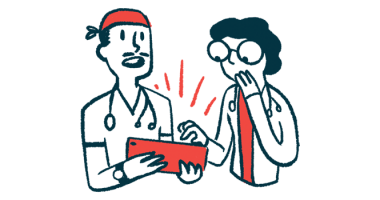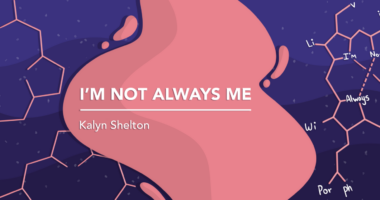My Strength Might Inspire You, but I’m a Total Fraud

Acute intermittent porphyria (AIP) doesn’t define who I am, but it does control what I can do.
And my tendency is to talk about that. I will voice my daily struggles, reflect on my hospitalizations, and speak up about the permanent nerve damage caused by nearly two decades of untreated attacks. I see value in the connections, awareness, and healing that comes from sharing my truth.
What I’m seemingly never prepared for are the well-meaning responses I receive.
Here’s the one I get the most: “You are so strong.”
When people who don’t fight their own constant battle for wellness tell me that, it’s meant as a compliment. But here’s the thing: I’ve been chronically ill since age 14. I never got a taste of what it’s like to be healthy. I carry myself with my head held high despite my pain. I white-knuckle it to get through the day, and I wouldn’t call that being strong.
Rather, it stems from a desire to please and avoid the self-judgment that comes with admitting my body is limited in some way. When I take my dog for a walk days after discharge from the hospital, it’s not strength I’m portraying. It’s desperation to live some semblance of a normal life. It’s the result of pushing myself, of testing my limits. And I will summon the sheer willpower to do so until my body gives way.
The thing about willpower is that I learned to develop it over time.
When my doctors repeatedly told me my pain was in my head, I decided it was up to me to move past it. I could distract myself from my symptoms by staying busy and compulsively achieving lofty goals. In doing so, some deep-down, subconscious part of me thought my accomplishments could cure my maladies.
In the process, I pushed my mind and body so far away from each other that they are now complete strangers. Due to this disassociation, I was able to turn off my excruciating abdominal pain and run for long distances. For years leading up to my diagnosis, I trained for marathons, ran races, and even became a certified running coach. My willpower to be healthy prevented me from seeking medical attention after races, when I would spend nights vomiting and in a fetal position on the bathroom floor.
I completed two master’s degrees during a period of my life when I completely ignored all of my body’s needs, and focused instead on the magical healing outcomes that would surely find their way to me once I finished my course of study. At the end of three years, what I graduated with was not a set of useful credentials, but further expertise in shutting out my body’s needs.
It’s been three years since I received an AIP diagnosis, proving that my pain and symptoms weren’t in my head. And while I recognize my need to achieve was an unhealthy habit born of fear, I remain more concerned with my image and preoccupied with not appearing sick. There’s nothing warrior-ish about faking it.
When I peel back the layers and consider how I neglect my body’s basic needs, it looks much more like being weak.
How do I begin to build a bridge that spans the gaping cavern between my body and my mind? I can start by recognizing that my body is perhaps sorer, more tired, and more limited than other people’s bodies at my age. But just like busying myself with goals doesn’t cure my illness, pushing myself to appear “normal” doesn’t change the fact that I’m fighting an invisible battle.
My challenge is to embrace the strength in the silent, peaceful moments when I choose to honor my body by staying in bed. My challenge is to be less concerned about what friends or neighbors think, and more focused on how the actions I take are in my body’s best interest. Inviting my mind back into this volatile, challenging body will require intention, consistency, time, and trust.
Inviting my mind back into my body will require true strength.
***
Note: Porphyria News is strictly a news and information website about the disease. It does not provide medical advice, diagnosis, or treatment. This content is not intended to be a substitute for professional medical advice, diagnosis, or treatment. Always seek the advice of your physician or other qualified health provider with any questions you may have regarding a medical condition. Never disregard professional medical advice or delay in seeking it because of something you have read on this website. The opinions expressed in this column are not those of Porphyria News or its parent company, Bionews, and are intended to spark discussion about issues pertaining to porphyria.








Comments
Sharon Dill
Claire, thank you for your incredible honesty in sharing this very personal side of living with AHP. The more we can be honest with ourselves, we can be honest with others - and hopefully help them to know they are not alone.
Claire Richmond
Sharon! Thank you for your comments and for, in turn, always being completely honest with me. You are one of the most important people I've met on this porphyria journey and remind me not to care so much about appearances, but focus more on being gentle to my body. I agree, the more we speak up, the more others can relate! xo
Joni Welda
Thank you for this article-I too suffer the permanent nerve damage and brain/body dissociation due to Variegate Porphyria. A lifetime of pain, pushed aside and becoming an "overachiever" seeking constant acceptance for my achievements, denying what was causing all the pain. After many misdiagnosis, countless medications that caused neurologic symptoms and unknown "attacks", at age 65,I'm just getting to know the real "me" and acknowledging my limitations and the disease that does not label who I am but definitely dictates what I can and cannot do. Thank you for putting into words what many of us live every day-well done!
Claire Richmond
Joni- I have so much empathy for what you've gone through and are going through. Thank you for sharing your story, I think it will only help others!